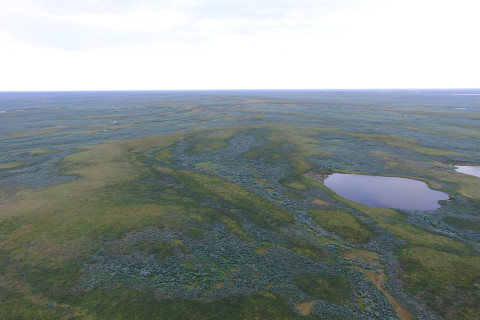As Arctic summers warm, Earth’s northern landscapes are changing. Using satellite images to track global tundra ecosystems over decades, a new study found the region has become greener, as warmer air and soil temperatures lead to increased plant growth.
“The Arctic tundra is one of the coldest biomes on Earth, and it’s also one of the most rapidly warming,” said Logan Berner, a global change ecologist with Northern Arizona University in Flagstaff, who led the recent research. “This Arctic greening we see is really a bellwether of global climatic change – it’s this biome-scale response to rising air temperatures.”
The study, published this week in Nature Communications, is the first to measure vegetation changes across the Arctic tundra, from Alaska and Canada to Siberia, using satellite data from Landsat, a joint mission of NASA and the U.S. Geological Survey. Landsat data can be used to determine how much actively growing vegetation is on the ground – greening can represent plants growing more, becoming denser, or shrubs encroaching on typical tundra grasses and moss.

From the University of Eastern Finland, Professor Timo Kumpula at the Department of Geographical and Historical Studies and Researcher Pentti Zetterberg at the School of Forest Sciences participated in the study. The study made use of, e.g., growth ring samples from Arctic willows, which Professor Kumpula and Professor Bruce Forbes from the University of Lapland have collected from Fennoscandia, West Siberia and Yakutia. Pentti Zetterberg performed dendrological analyses of the samples.
“The data we have collected over the past ten years proved to be valuable reference data from the field, allowing us to verify the greening observed from the satellite data,” Professor Kumpula says.
Collaboration in research addressing changes in the Arctic area will continue in Professor Kumpula’s newly launched project LANDMOD, which is funded by the Academy of Finland.
When the tundra vegetation changes, it impacts not only the wildlife that depend on the certain plants, but also the people who live in the region and depend on local ecosystems for food. While active plants will absorb more carbon from the atmosphere, the warming temperatures could also be thawing permafrost, releasing greenhouse gasses
Increased vegetation growth captures more carbon from the atmosphere. At the same time, however, rising temperatures cause permafrost to melt, releasing more greenhouse gases into the atmosphere.
The research is part NASA’s Arctic Boreal Vulnerability Experiment (ABoVE), which aims to better understand how ecosystems are responding in these warming environments and its broader implications.
Berner and his colleagues used the Landsat data and additional calculations to estimate the peak greenness for a given year for each of 50,000 randomly selected sites across the tundra. Between 1985 and 2016, about 38% of the tundra sites across Alaska, Canada, and western Eurasia showed greening. Only 3% showed the opposite browning effect, which would mean fewer actively growing plants. To include eastern Eurasian sites, they compared data starting in 2000, since that’s when Landsat satellites began collecting regular images of that region. With this global view, 22% of sites greened between 2000 and 2016, while 4% browned.
“Whether it’s since 1985 or 2000, we see this greening of the Arctic evident in the Landsat record,” Berner said. “And we see this biome-scale greening at the same time and over the same period as we see really rapid increases in summer air temperatures.”
The researchers compared these greening patterns with other factors, and found that it’s also associated with higher soil temperatures and higher soil moisture. They confirmed these findings with plant growth measurements from field sites around the Arctic.
“Landsat is key is for these kinds of measurements because it gathers data on a much finer scale than what was previously used”, said Scott Goetz, a professor at Northern Arizona University who also worked on the study and leads the ABoVE science team. That allows the researchers to investigate what is driving the changes to the tundra. “There’s a lot of microscale variability in the Arctic, so it’s important to work at finer resolution while also having a long data record,” Goetz said. “That’s why Landsat’s is so valuable.”

For further information, please contact:
Professor Timo Kumpula, tel. +358 50 372 8566, timo.kumpula(at)uef.fi
Research article:
Logan T. Berner, Richard Massey, Patrick Jantz, Bruce C. Forbes, Marc Macias-Fauria, Isla Myers-Smith, Timo Kumpula, Gilles Gauthier, Laia Andreu-Hayles, Benjamin V. Gaglioti, Patrick Burns, Pentti Zetterberg, Rosanne D’Arrigo & Scott J. Goetz. Summer warming explains widespread but not uniform greening in the Arctic tundra biome. Nature Communications volume 11, Article number: 4621 (2020). https://www.nature.com/articles/s41467-020-18479-5

